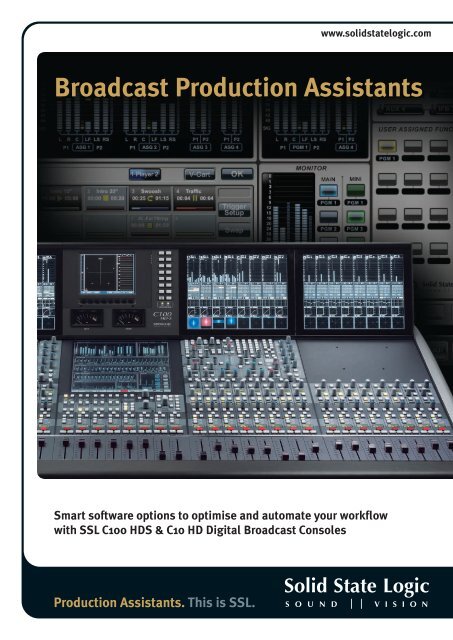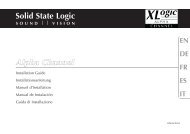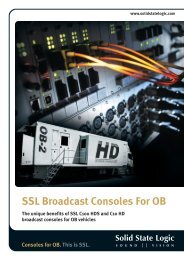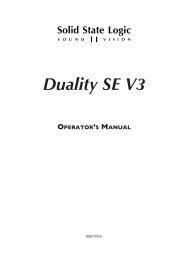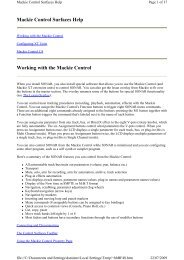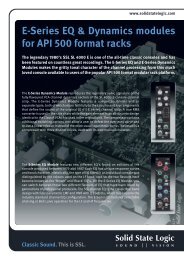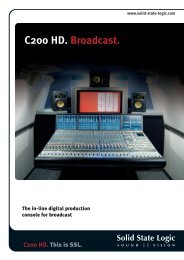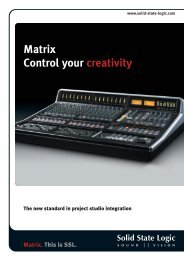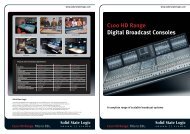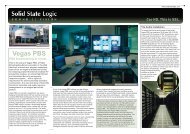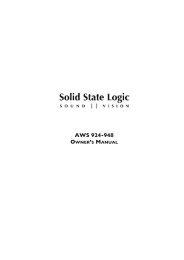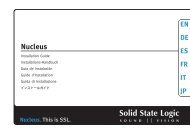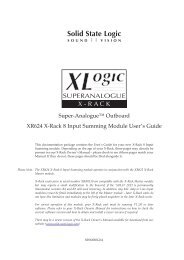Broadcast Production Assistants - Solid State Logic
Broadcast Production Assistants - Solid State Logic
Broadcast Production Assistants - Solid State Logic
- No tags were found...
Create successful ePaper yourself
Turn your PDF publications into a flip-book with our unique Google optimized e-Paper software.
www.solidstatelogic.com<strong>Broadcast</strong> <strong>Production</strong> <strong>Assistants</strong>Smart software options to optimise and automate your workflowwith SSL C100 HDS & C10 HD Digital <strong>Broadcast</strong> Consoles<strong>Production</strong> <strong>Assistants</strong>. This is SSL.
www.solidstatelogic.com<strong>Broadcast</strong> <strong>Production</strong> <strong>Assistants</strong>Smart software options to optimise and automate your workflowDialogue AutomixAutomated mixing of fast paced multi-mic talk showsSSL <strong>Production</strong> <strong>Assistants</strong> are a range of unique software options designed to streamline broadcast productionworkflow with C100 HDS and C10 HD digital broadcast consoles. Each offers an innovative solution to a specific modernbroadcast production challenge. They are all integrated into the console surface, placing hands-on control at the heartof your workflow. Most automate key production tasks leaving experienced engineers free to concentrate on otheraspects of the production or enable non specialist operators achieve professional results.Options Include:• Dialogue Automix: Automated mixing of fast paced multi mic talk shows.• C-Play: Dual player cart style audio playout built into the console surface.• 5.1 Upmix: Convincing and adjustable Stereo to 5.1 Upmixing and Downmixing.• <strong>Production</strong> Automation Integration: Integration with Ross, Sony & Mosart <strong>Production</strong>/Newscast Automation systems.• DAW Control: Maximise studio productivity with console DAW control for post production.Hope Channel <strong>Production</strong> Center“We use the ‘Dialogue Automix’ extensively. Every programthat we’ve done has used it and it works incredibly well. Wehave used up to five mics simultaneously for our productionsand riding all those levels manually is very difficult andstressful for our engineers. This one feature has increased thequality of the audio and lowered the audio operator’s workload at the same time.”Joe Sloan, Operations & <strong>Production</strong> ManagerNext Radio TV Group“The C10 stood out by offering features not available on otherconsoles. For example, the Dialogue Automix really helps ourengineers attain superior mixing results for live panel shows. Inthe past, handling these programs was a daunting engineeringchallenge. Now our engineers can not only accomplish the basicmixing mission, but now have time to refine the sound qualityand pay more attention to the video aspects of the program.”Philippe Espinet, CTOOne of the most physically challenging tasks facing a broadcast engineer is riding the faders to maintain a smooth,balanced mix in the fast paced environment of a multi microphone talk show. SSL’s unique Dialogue Automix systemprovides software driven automation of this process. Dialogue Automix assists skilled and unskilled audio mixers inmanaging multiple live mics without having to continually ride their individual faders to eliminate spill and roomcolouration. Once a relative level has been set for each microphone, the system detects which mics are receiving an inputand makes fast, transparent crossfades between them, freeing the mix engineer to focus on balance and sound qualityrather than be chained to the faders. These voice-controlled crossfades closely track unpredictable dialogue, eliminatingcue mistakes and late fade-ups, while avoiding the choppy and distracting effects common to noise gates. The overall gainof multiple active channels is automatically adjusted to keep the overall output equivalent to a single channel, thuseliminating obtrusive fluctuations in background noise when more than one channel is contributing to the mix.Dialogue Automix is freely assigned on a per channel basis up to a maximum of 16 channels. The system can be used witha mixture of local studio and remote location sources including OB units and telephone lines . The system provides a‘Weight’ control on each channel which lets the operator establish relative ‘priority’ for individuals when multiplechannels are open at once. The primary use of the weight control is to enable the host to ‘talk down’ other showparticipants. Lowering the weight control on a channel decreases the channel gain during ambience and lowers therelative gain if the channel is active with other channels. Raising the weight, increases the gain during ambience andincreases the relative gain if that channel is active with other channels. It is also possible to globally adjust the automaticfade-in time when channels are opened using an Attack control and the rate of return to the ambient gain setting to avoidpumping effects between words using a Release control. Automix activity is shown in the Channel displays with clearindication of which channels are assigned to Automix and level meter indication of individual channel gain reduction.Key Features• Automated mixing for fast paced multi mic talk shows• Automatically cross fades between mics• Maintains consistent ambient noise levels• Up to 16 channel control simultaneously• Works with audio sources at multiple locations• Weight control sets priority for individual speakers• Globally adjustable Attack and Release times• Activity indication in channel Displays<strong>Production</strong> <strong>Assistants</strong>. This is SSL.
www.solidstatelogic.comC-PlayIntegrated spot and music Playout systemThe C-Play system embeds a fully functional spot and music Playout system into the C100 HDS or C10 HD. Audio filePlayout systems for spots and music are an essential part of everyday broadcast operations. Until now, broadcastershave been faced with sourcing dedicated Playout systems and preparing console Project and Playout systemsindividually. C-Play offers the broadcaster sophisticated fully featured Playout functionality with the significantergonomic and workflow advantages of an embedded system, with console hardware control and where all Playoutsettings are recalled as part of a console Project.C-Play is a dual player system with one 5.1 player and one stereo player which can be independently assigned to anyconsole channel. Once assigned the Channel Info screens show currently selected Cut, duration and playback status,including time remaining and end warning flash. Audio files are stored in a shared network location with bulk importcapability streamlining import from a craft editor or library. A comprehensive Cut Creation interface facilitates nondestructive editing where a single source file can be used to create multiple Cuts with trimming of Start/End points, FadeIn/Out and a sophisticated Loop Play system. A dedicated Playlist creation interface streamlines the assembly of cuts intoPlaylists. Playlists have comprehensive one shot, sequential or automated playback and advanced playback controlsincluding crossfades and playlist looping. All Cut, Playlist and Assignment options are project based so when your consoleProject is recalled your entire Playout system is also recalled, dramatically streamlining turnaround between shows.Each Player has three different playback control interfaces;‘V-Cart’ mode provides a list view enabling fast intuitivelocation and start/stop/retrigger of individual Cuts viaa combination of touch screen and console centresection hardware push-select rotary encoder.Key Features• Embeds Spot & Music Playout system into console surface• Project based settings aide fast show turnaround• Two independent ‘Players’; one 5.1 and one stereo• Channel Info display of selected Cut, duration and playback status• Files are stored on networked storage drive with bulk import support• Fast intuitive combination of touch screen and hardware encoder operation• Playback control from touch screen, hardware encoder, fader start or GPI• Three player modes;* ‘V-Cart’ mode; fast intuitive individual Cut selection and triggering via touchscreen and hardware encoder* ‘FreePlay’; 16 touch screen buttons for random access to 16 files simultaneously* ‘PlayList’; fast intuitive playlist selection and triggering via touchscreen and hardware encoder• Cut Creation interface enables non destructive Start, Stop, Fade and Loop settings independent of source file‘FreePlay’ mode provides a paged 16 button touchscreeninterface where multiple Cuts can be triggered instantly.The 6 pages of 16 touch triggers can be switched betweenthe two independent players to give access to a hugepallete of sounds.‘PlayList’ mode uses the list view interface for location,selection and start/stop/retrigger of Playlists.In addition to the touchscreen control, playback can becontrolled using Fader Start for hands on operator controlor assigned to GPI control for triggering via a wide range ofexternal devices or Automation systems.<strong>Production</strong> <strong>Assistants</strong>. This is SSL.
www.solidstatelogic.com5.1 UpmixConvincing and adjustable Stereo to 5.1 Upmixing and DownmixingEnsuring a smooth transition between 5.1 and stereo audio material is a common broadcast challenge.Our ‘5.1 Upmix’ option automatically creates a 5.1 surround mix from a stereo audio source and makes it available formanipulation. Upmixed 5.1 can easily be downmixed back to stereo or mono without any artefacts such as phasecancellation or comb filtering being generated in the downmixed audio.5.1 Upmix can be applied to any stereo console channel. The system extracts spatial data from the components of thestereo signal to create a convincing 5.1 feed. While a 'Centre' signal provides a soundfield anchor, the spatial elementscan be positioned around the Centre to mould a convincing 5.1 effect for the stereo signal.When 5.1 Upmix is assigned to a specific channel, a range of parameters are available for adjustment via assignablehardware controls within the channel strip. The ranges through which each pan parameter can be adjusted has beenlimited through careful listening tests to allow a diverse range of stereo sources to be upmixed without developingextreme or unconvincing spatial effects. Parameters available for adjustment include:• Centre signal level trim (C-DB) affects the stereo width of the front image. Nominally set to 0dB, increasing the levelwill narrow the image and decreasing the level will widen the image.• Centre divergence (C-DV) controls the spread of the front image. Normally set to 50%, a setting of 100% removes allsignal from the Centre Channel giving a 4.1 Upmix often required when up mixing stereo ambience with dialogue inthe centre channel.• Bias (BIAS) alters the front/rear perspective. Increasing the bias towards the rear gives the perception of signalsemanating from behind the listening position and is useful for increasing the effect of surround channels inambience processing.• Spatial signal front/rear panning (DPTH) controls the surround channels’ contribution and the distribution of the5.1 soundfield. The default setting is half-way back, giving a diffuse 5.1 spread; increasing the depth moves thesignal to the back and increases the spatial width.• LFE gain (LFDB) affects the Low Frequency Effect level. Turn the Lower Quik-Knob to adjust the L-R pan.<strong>Production</strong> AutomationIntegration with <strong>Production</strong>/Newscast Automation systemsRecognizing that live <strong>Production</strong> Automation is a growing part of broadcast production,C100 and C10 consoles can beintegrated with Ross Overdrive, Sony ELC and Mosart Medialab systems. Fundamentally the SSL <strong>Broadcast</strong> Automationinterface provides the Ross, Sony or Mosart Medialab automation system with a remote controlled mixer. This mixerfollows commands issued from the Automation System (or the vision mixer/switcher) and thus controls the audio mix ofthe production. The Automation System works in parallel with the console’s physical controls, so if the audio operatoradjusts the level of a channel under automation control, the audio will change level. The fact that the level has changedwill also be flagged to the automation system. The limited abilities of the Automation System (fader level, on/off etc.)mean that the console is likely to be pre-configured for a specific show, to set mic gains, EQ’s, master bus settings etc.This can all be simplified by the creation of projects to work with specific automated productions. Automation can beapplied to anything from a single channel to all channels of the console but typically a small number of channels arecontrolled. Using custom layers, the Channel faders under control can be hidden from the operator’s view of the surface,so that the console can be used simultaneously by an operator and the automation system without distraction.Automation can globally be switched on/off from a single console surface switch.Key Features• Support for Ross, Sony and Mosart Medialab• Available for C10 and C100• Automation can be applied to anything form a single channel to all channels of the console• Channel faders under control can be hidden from the operator’s view• Automation can globally be switched on/off from the console surfaceKey Features• Convincing Upmixing from Stereo to 5.1• Downmixing from 5.1 down to stereo without unwanted artefacts• Can be applied to any console stereo channel• Front image stereo width adjustment• Front image Centre divergence adjustment• Front/Rear perspective control• Spatial Front/Rear panning control• LFE gain control<strong>Production</strong> <strong>Assistants</strong>. This is SSL.
www.solidstatelogic.comDAW ControlMaximise studio productivity with console DAW control for post productionThe C100 and C10 can provide an ergonomic control surface for a wide range of popular DAW packages, allowing broadcastpost-production to be carried out in existing audio control suites whenever they are not being used on-air. The ability to control thetransport, dynamic automation and audio parameters within the DAW permits complex mixes to be created, and these projects canbe moved from one room to another without having to separate audio and automation data, simplifying workflow.When the console is assigned to DAW control, it acts a control surface for the ‘virtual’ console inside the DAW. With the DAW trackspresented on the console control surface, the Fader Strip faders, encoders, and ON/OFF functions control DAW channels, andassignable channel buttons provide track record functions. Sends and I/O functions can also be modified. Cue and automation datais generated by the DAW, not the console. DAW transport controls can be assigned to console centre section buttons.The C100 and C10 use the HUI protocol providing a generic control interface with excellent real-time operation without the controllatencies often experienced with other controllers. The console uses MIDI over Ethernet to connect with DAWs. Each virtual MIDI portsupports eight fader channels, and the maximum number of ports a single DAW can use is four (32 channels) – DAW and consoleframe size permitting! The console layout is fully customizable so that DAW control channels and the consoles internal audiochannels can be placed alongside each other if required. The consoles audio processing and monitoring capabilities can be usedalongside DAW control to provide a powerful and versatile production environment.Key Benefits• Maximise productivity using studios foraudio post during ‘off-air’ time.• Use console hardware controls tomanipulate DAW parameters.• Hybrid mixing environment with DAW andconsole processing used simultaneously.• Customisable console layout enablesplacement of DAW control and audiochannels side by side.• Uses HUI control with MIDI over Ethernetconnectivity.• Compatible with Pro Tools ® , <strong>Logic</strong>, Nuendoand most other leading DAW packages.<strong>Solid</strong> <strong>State</strong> <strong>Logic</strong>International HQ: Begbroke, Oxford, England OX5 1RU · Tel +44 (0)1865 842300 · sales@solidstatelogic.comCologne: Tel +49 7001 8658 42300 · sales@solidstatelogic.comLos Angeles: Tel +1 323 549 9090 · lasales@solidstatelogic.comMilano: Tel +39 (0)392 328 094 · itasales@solidstatelogic.comNew York: Tel +1 212 315 1111 · nysales@solidstatelogic.comParis: Tel +33 (0)1 48 67 84 85 · frsales@solidstatelogic.comSingapore: Tel +65 6438 2272 · sales@solidstatelogic.comThailand: Tel +66 2 587 5111 · Email akaraphol@ssl-bkk.comTokyo: Tel +81 (0)3 5474 1144 · jpsales@solid-state-logic.co.jpZagreb: Tel +38 513 079 405 · sales@solidstatelogic.com© <strong>Solid</strong> <strong>State</strong> <strong>Logic</strong>. All Rights reserved under International and Pan-American Copyright Conventions. <strong>Solid</strong> <strong>State</strong> <strong>Logic</strong> and SSL are trademarks of <strong>Solid</strong> <strong>State</strong> <strong>Logic</strong>.All other trademarks are the property of their respective owners. No part of this publication may be reproduced in any form or by any means, whether mechanical or electronic, without thewritten permission of <strong>Solid</strong> <strong>State</strong> <strong>Logic</strong>, Oxford, England. <strong>Solid</strong> <strong>State</strong> <strong>Logic</strong> has a policy of continual product enhancement and reserves the right to alter specifications without notice. E&OE<strong>Production</strong> <strong>Assistants</strong>. This is SSL.


